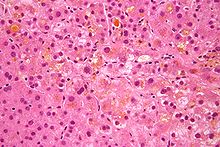User:Mr. Ibrahem/Cholestasis
| Cholestasis | |
|---|---|
| Other names | Cholestatic liver disease, cholestatic jaundice |
 | |
| Micrograph showing bile (yellow) stasis, i.e. cholestasis. H&E stain. | |
| Specialty | Gastroenterology |
| Symptoms | Itchiness, fatty stool, tiredness, fatty deposits in the skin, yellowish skin and eyes[1] |
| Complications | Fat soluble vitamin deficiency[1] |
| Types | Extrahepatic, intrahepatic[1] |
| Causes | Extrahepatic: Common bile duct stones, bile duct strictures, sclerosing cholangitis, bile duct cancer, pancreatic cancer[1] Intrahepatic: Viral hepatitis, alcoholic hepatitis, certain medications, pregnancy, sepsis, cystic fibrosis, primary biliary cholangitis[1] |
| Diagnostic method | High direct bilirubin and high serum alkaline phosphatase[1] |
| Treatment | Surgery, medication[1] |
| Medication | Cholestyramine, ursodeoxycholic acid, antihistamines, naloxone[1] |
| Frequency | Commons[2] |
Cholestasis is a condition of decreased bile production or flow from the liver to the intestines.[1] Symptoms may include itchiness, fatty stool, tiredness, fatty deposits in the skin, and yellowish skin and eyes.[1] Complications may include deficiencies of fat soluble vitamins.[1]
The causes are divided into those outside the liver and those within the liver.[1] Causes outside the liver include common bile duct stones, bile duct strictures, sclerosing cholangitis, bile duct cancer, and pancreatic cancer.[1] Causes within the liver include viral hepatitis, alcoholic hepatitis, certain medications, pregnancy, sepsis, cystic fibrosis, and primary biliary cholangitis.[1] Blood tests may show a high direct bilirubin and serum alkaline phosphatase.[1]
Treatment depends on the underlying cause and symptoms.[1] Blockages of the bile ducts may be treated by surgery.[1] Itchiness may be improved with cholestyramine, ursodeoxycholic acid, antihistamines, and naloxone.[1] Other options for itchiness may include light therapy and plasmapheresis.[1] Cholestasis is common, with blockage of bile ducts the most frequent type.[3][2] The term "cholestasis" is from the Greek for "standing still of bile".[4]
References[edit]
- ^ a b c d e f g h i j k l m n o p q r s Shah, R; John, S (January 2020). "Cholestatic Jaundice". PMID 29489239.
{{cite journal}}: Cite journal requires|journal=(help) - ^ a b Samant, H; Manatsathit, W; Dies, D; Shokouh-Amiri, H; Zibari, G; Boktor, M; Alexander, JS (6 July 2019). "Cholestatic liver diseases: An era of emerging therapies". World journal of clinical cases. 7 (13): 1571–1581. doi:10.12998/wjcc.v7.i13.1571. PMID 31367616.
{{cite journal}}: CS1 maint: unflagged free DOI (link) - ^ Burtis, Carl A.; Ashwood, Edward R.; Bruns, David E. (2012). Tietz Textbook of Clinical Chemistry and Molecular Diagnostics - E-Book. Elsevier Health Sciences. p. 1676. ISBN 978-1-4557-5942-2.
- ^ Clinic, Cleveland (2010). Current Clinical Medicine E-Book: Expert Consult - Online. Elsevier Health Sciences. p. 552. ISBN 978-1-4377-3571-0.
